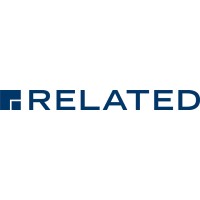5 Reasons to Plan ADA Signage
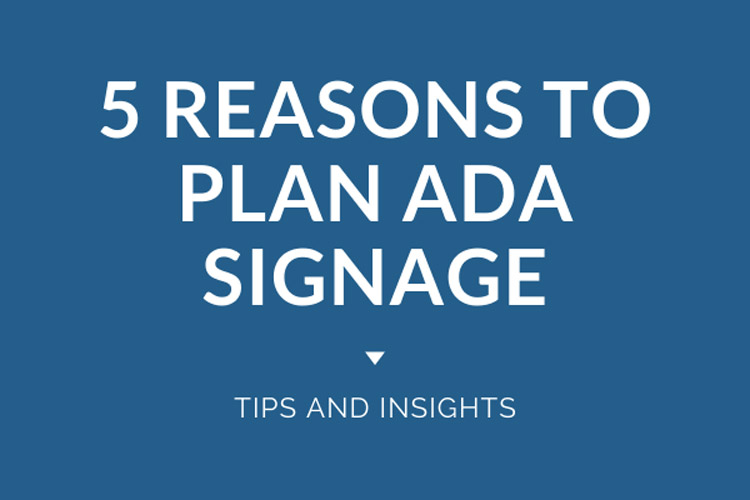
Table of Contents
Plans are moving along, construction has started, and the project is coming together. You’re getting through your checklist. The next item you need to check off? The fire marshal walk-through. And you realize your signage is not up to the federal Americans with Disabilities Act (ADA) Standards for Accessible Design.
It dawns on you: you may not gain occupancy on your target date.
The American with Disabilities Act (ADA) became Federal law in 1990. The 2010 ADA standards updated the 1991 version and was effective in March 2012, requiring any building to be current within the Federal and Local ADA guidelines before gaining a permit for any type of renovation.
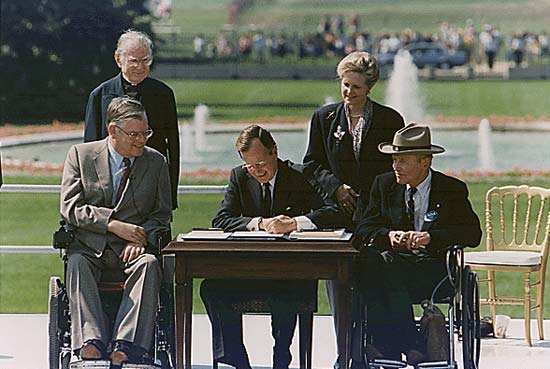
This is not the only scenario. Without required ADA compliant signage, you will not be able to turn the property over to the owner or you cannot gain occupancy. ADA can be a straightforward process – everyone has a bathroom; everyone has an electrical room. Those are simple to address because signs are mass-produced and can be generic. But when it comes to customizing aspects of your installation, for example adding individual room numbers to server rooms, the process can get complicated.
Project managers have enough on their plate. Why pile on the “to-do” list with another task.
Especially when it involves a very dense set of rules that are not easy to follow and places several compliance requirements on architects, general contractors, and others involved in the design, construction, and maintenance of public buildings.
Buildings that are providing signage within public spaces require this to meet compliance with the ADA standards to accommodate people with visual disabilities. Unfortunately, we have seen many buildings get delayed from opening because they do not adhere to the guidelines. It is not because people do not want to follow them: they think about them late in the process.
Here are some reasons why you should not wait to think about the process and planning.
Pictograms (not to be confused with Pictionary)
While not required, pictograms are helpful to visitors. They display visuals such as stairs and fire exits. In some instances, you can customize pictograms. For example, some states, like Hawaii, will allow use of a ‘hula girl’, in conjunction with the standard female symbol. Other states are stricter. Custom pictograms are possible in Chicago, but we would need to know you are considering using from day one.
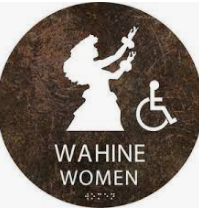
It allows us to time to check if custom pictograms, can be used with compliance. If we can research this ahead of time, it should not delay the production process. If you go this creative route, just account for space. Letters cannot be smaller than 5/8 of an inch.
Time — OCCUPANCY
Just like the Pink Floyd songs says, “ticking away the moments that make up the dull day.” Before you know it, you are ready to open the doors. What if your signage is not ready for inspection by a fire marshal looking for ADA compliance? It can take four to six weeks for signage to receive approval. It is common sense to consider ADA at the beginning of your project.
Some things to consider:
- All signs are made to order
- Quality assurance process is manual and takes time (each sign must be individually checked)
- Spacing requirements – remember letters cannot be smaller than 5/8 of an inch.
Time gives you more sign options and helps to narrow down choices. Talking with sign companies at the beginning also gives you the option to review hardcopy samples. So, you can have an overall feel of what you will be ordering and how they will look. Signs do get pricey so it would be disappointing to wait all that time, and not get what you expected.
Burnham Nationwide is the industry leader in building permit expediting and code consulting, leveraging over 25 years of experience navigating the permit and code compliance process. We caught up with their team on why you should consider signage toward the beginning of your project.
“Signage is critical in wayfinding for occupants of a building, service and fire department personal and even more so for a person who is blind or visually impaired. With so many requirements specific to use (directional or room/space), color and text contrast, size of text, and type of pictogram, starting early in the design process is pivotal to ensure these are ready to go when needed.”
Leah Riley, Senior Code Consultant, Burnham Nationwide Inc.
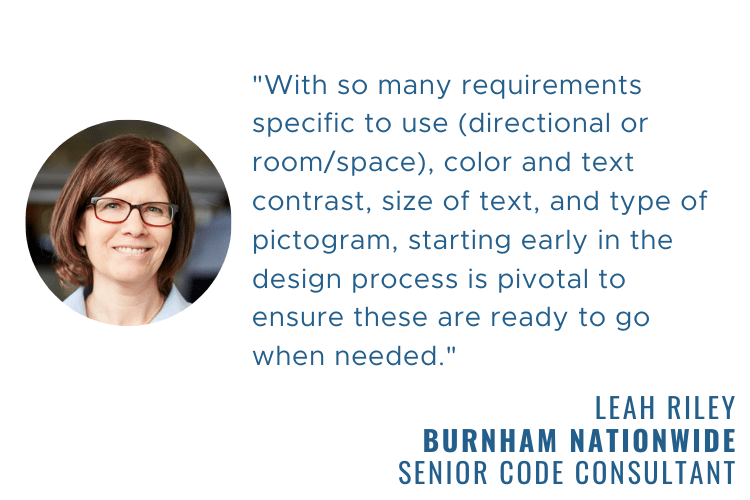
Brand Building
Often customers want to use brand colors. This is a great idea and keeping your brand consistent across all channels can increase revenue. So, using your custom color scheme is great, but again, this is time-consuming. Consider:
- Paints need to be mixed
- Color swatches need to be reviewed
- and most importantly the graphics need to be produced
There is a palette of colors pre-approved for braille and ADA if you decide not to incorporate your brand. But why do that? Discuss anything custom with your design team at the beginning so they can create files with ADA in mind. Signage will serve a dual purpose: protect people with disabilities and be consistent with your overall brand.
List Details
The most tedious part of organizing signage is the messaging list. This is a manually typed list to call out each line that will need raised copy. Ever walked past a braille sign and brushed your fingers over raised letters and numbers? These each must be accounted for in a spreadsheet, Including the symbols. It also has quantities and different sign types.
So, for large orders, it can take a couple of days to make sure all signs are accounted for and proofread.
Here is a sampling of this project spreadsheet:
![]()
Related Midwest is a progressive leader in the development of award-winning real estate and the preservation of landmark buildings.
We’ve had the opportunity to collaborate with them on different ADA compliant signage projects and their team prioritizes planning to bring these installation to fruition. We asked them about the value of planning ahead:
“Early consideration of signage locations and types creates opportunities to cohesively reinforce branding, support marketing, and facilitate way finding in a way that enhances the resident and visitor experience.”
Frank Soldano, Vice President, Architecture and Design, Related Midwest
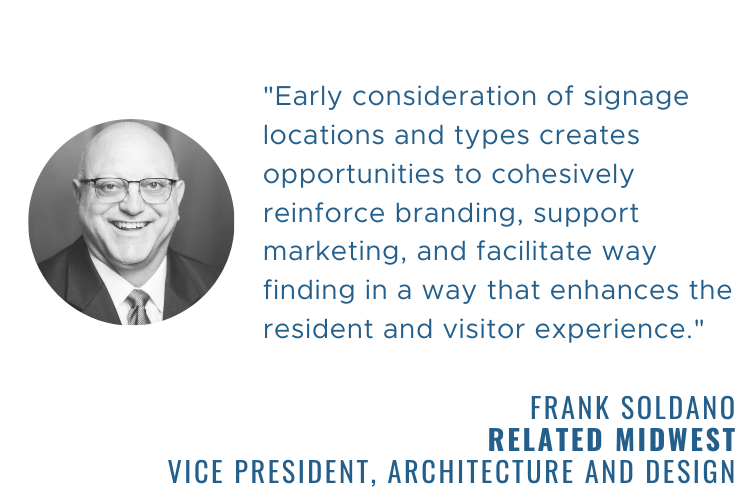
Cost Savings
“Spare no expense!” said no controller or project manager who handles a budget, ever. The reality is if you turn ADA signage into a rush consideration and last-minute turnaround project: prices will go up. If you are wondering if this is just a Cushing consideration, it is not. Most printers, fabricators, and vendors have projects lined up behind the scenes. All charge a rush fee when projects are postponed.
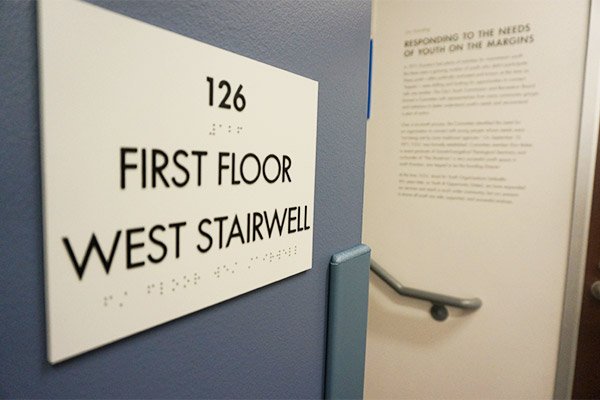
ADA Signage Example
Rush orders soak up staff members, push other projects from the queue, and quite literally cost the company – does not matter which printer you choose, Cushing or otherwise – time and money.
Grand Closing
Imagine your project is complete and you cannot open the doors. Not because they are jammed, of course. No, it will be because the fire marshal who expects ADA compliant signs will not give an approval. This means your building owner cannot gain occupancy, which means you cannot move onto the next project.
Next Steps
In conclusion, build ADA considerations into the beginning of your project. It saves many headaches and keeps another item on your checklist under control.


